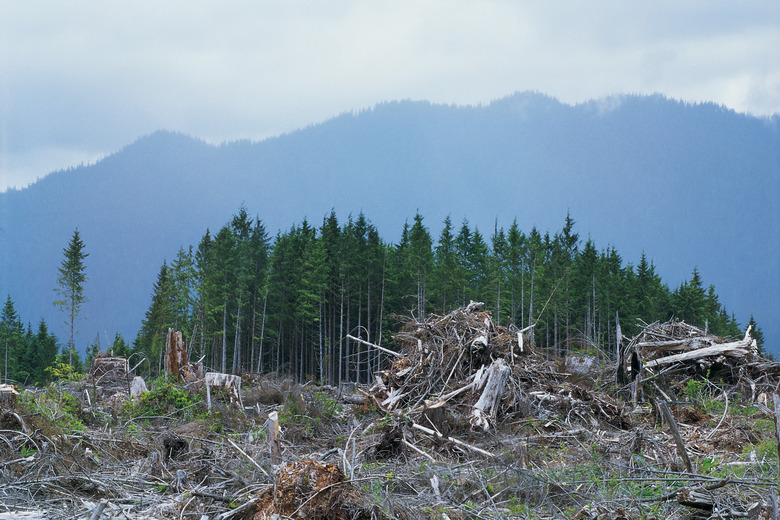Timber Industry Effect On Water Pollution
Forests play an important role in protecting the integrity of aquatic systems. Forest harvest can dramatically change the physical and biological characteristics of watersheds, removing vegetative buffers that protect surface waters from the elements and altering the movement of water. Other activities associated with timber operations, such as application of fertilizer and pesticides, and the waste disposal practices of pulp paper mills, also contribute to water pollution. The U.S. Environmental Protection Agency reports that the industry's use of best management practices has reduced water pollution in recent decades but that pollution remains a significant problem.
Sediment and Flow
Sediment and Flow
Forest vegetation helps to regulate water flow into surface waters. Water is absorbed from the soil by plant roots and released into the atmosphere from leaves — a process known as evapotranspiration. The roots of plants also bind soil and protect it from erosion. Rainwater and melted snow drain unhindered from harvested areas, causing higher baseline flow and increasing the chance of flooding. Unprotected soil is easily washed into water, and soil disturbance by other activities, such as road construction, can exacerbate this problem. These results can have devastating effects on aquatic organisms that have adapted lifestyles to suit natural flow and sediment regimes. For instance, high flows during the spawning season may wash away fish eggs laid on the stream bottom. Many aquatic invertebrates require gravel or sand to live in and will not tolerate muddy stream bottoms. High flow and poor water clarity may also affect the ability of fish and invertebrates to capture prey. Problems caused by erosion are not restricted to fresh water habitats, as sediment travels downstream and collects in estuaries.
Chemical Pollution
Chemical Pollution
Inorganic fertilizers and synthetic pesticides are often used by timber operations to enhance tree growth. These substances are typically spread by helicopter, a method that can lead to excess application and direct contamination of surface waters. Fertilizer nutrients promote surplus growth of aquatic algae and plants. Oxygen in the water is depleted when large amounts of plant matter are broken down by bacteria. Fish and aquatic invertebrates experience physiological stress in low-oxygen conditions, with some species — such as trout, salmon and mayflies — being more sensitive than others. A second source of chemical pollution is the effluent produced by pulp mills. Mills are required to treat their waste, but the effectiveness of treatment facilities in removing contaminants varies. Mill effluent contains large quantities of nutrients and organic matter. Mill waste and pesticides contain organic chemicals, such as dioxins and benzenes, which are toxic to aquatic life. Effects include tissue damage, reproductive and developmental problems, immune deficiency, reduced growth and female-biased sex-ratios.
Light Pollution
Light Pollution
The amount of sunlight reaching surface waters increases dramatically when adjacent trees are harvested. Sunlight allows algae and plants to grow abundantly, leading to problems with oxygen depletion, and causes water temperature to rise. Warm water is less capable of holding oxygen than cold water, so this too can reduce levels of dissolved oxygen in the water. Cold-adapted fish species, like trout, are badly affected by high water temperature. Even a small increase in temperature accelerates fish metabolism, causing energy requirements to increase. Increased metabolic demand can reduce fish growth, as many forest streams and lakes do not contain enough prey to compensate for higher demand for food. Retaining forest buffers of 10 or more meters around surface waters helps to protect them from light and temperature effects.
Loss of Resources
Loss of Resources
Aquatic ecosystems in forested catchments are highly dependent on resources that fall from the surrounding forest. Many aquatic invertebrates feed on fallen leaves, organic particles and wood, and drift-feeding fish rely heavily on falling terrestrial invertebrates as a food source. Fallen logs create vital habitat for many aquatic creatures. Harvest of surrounding forest has mixed effects on aquatic organisms. For instance, forest clearance benefits invertebrates that feed on algae, while organisms that rely on leaves, wood and terrestrial prey can be negatively affected by short-term changes in food availability. Deciduous plant species re-establish within the first few years after harvest, but trees that provide other materials, such as conifer needles and large logs, take decades to re-establish.
References
- Forest Ecology and Management; Organic Matter Inputs into Headwater Streams of Southwestern British Columbia as a Function of Riparian Reserves and Time Since Harvesting; P. M. Kiffney and J. S. Richardson
- Southern Journal of Applied Forestry; Streamside Management Zones Affect Movement of Silvicultural Nitrogen and Phosphorus Fertilizers to Piedmont Streams; J. M. Segoces et. al.
- Chemosphere; Chemical Characterization of Organic Microcontaminant Sources and Biological Effects in Riverine Sediments Impacted by Urban Sewage and Pulp Mill Discharges; S. Chamarro et. al.
- Forest Ecology and Management;Effectiveness of Best Management Practices for Sediment Reduction at Operational Forest Stream Crossings; L. R. Wear et. al.
Cite This Article
MLA
Campbell, Kirsten. "Timber Industry Effect On Water Pollution" sciencing.com, https://www.sciencing.com/timber-industry-effect-water-pollution-23000/. 24 April 2017.
APA
Campbell, Kirsten. (2017, April 24). Timber Industry Effect On Water Pollution. sciencing.com. Retrieved from https://www.sciencing.com/timber-industry-effect-water-pollution-23000/
Chicago
Campbell, Kirsten. Timber Industry Effect On Water Pollution last modified August 30, 2022. https://www.sciencing.com/timber-industry-effect-water-pollution-23000/
